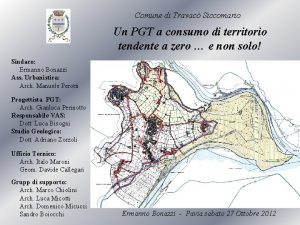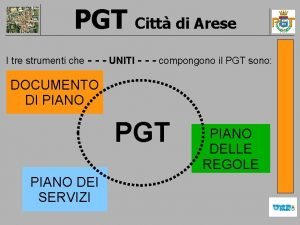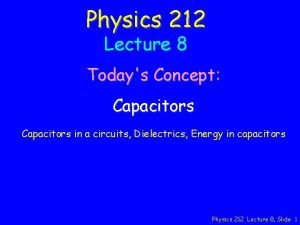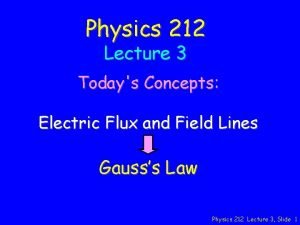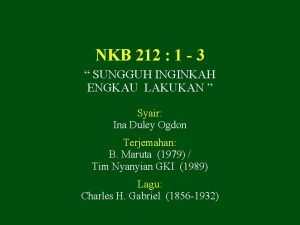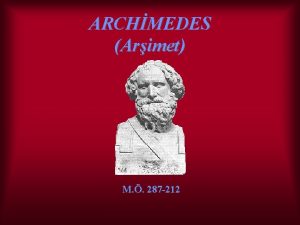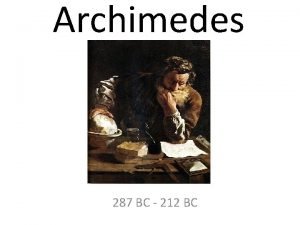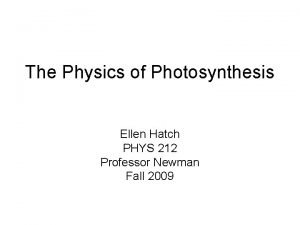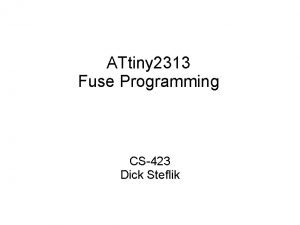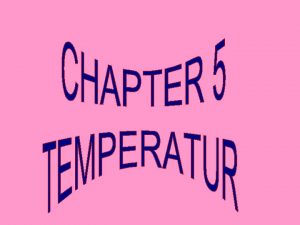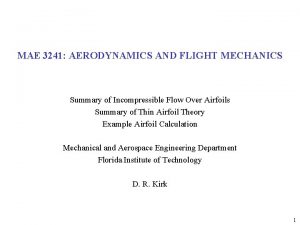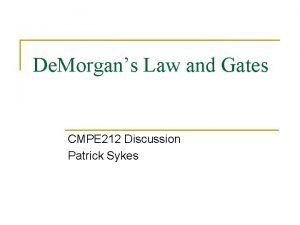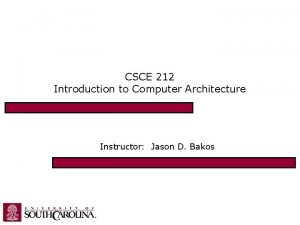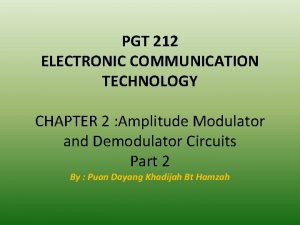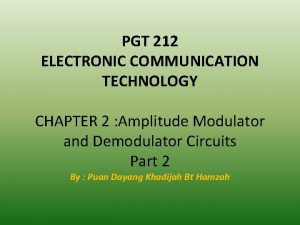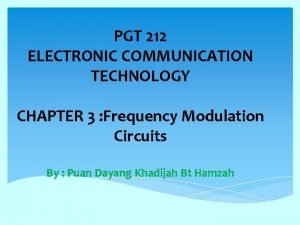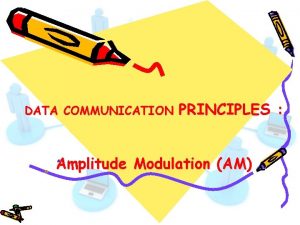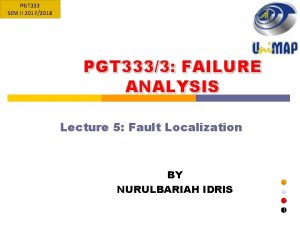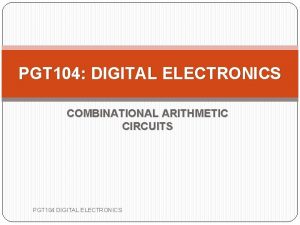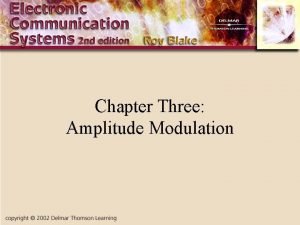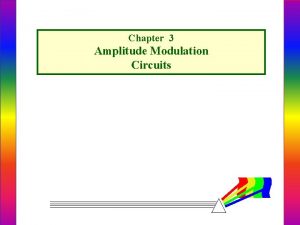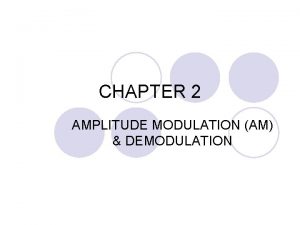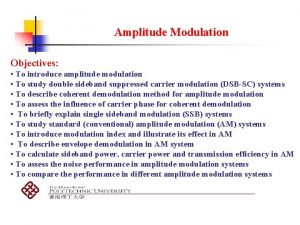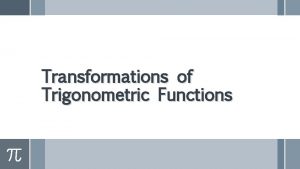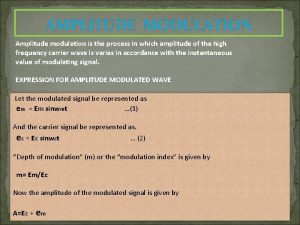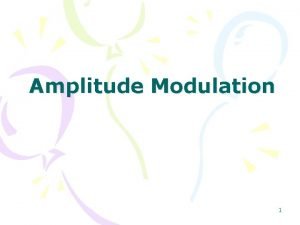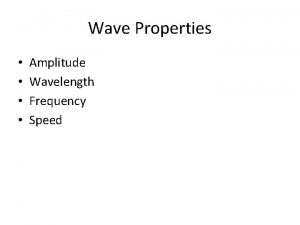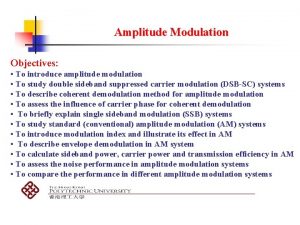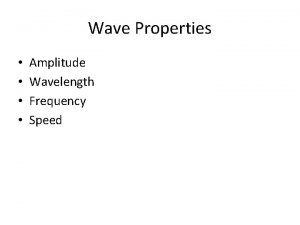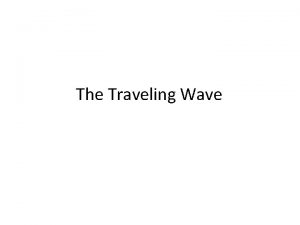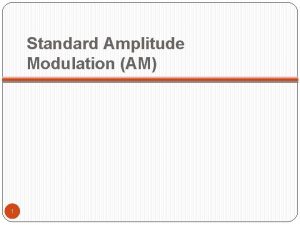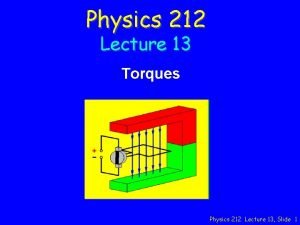PGT 212 ELECTRONIC COMMUNICATION TECHNOLOGY CHAPTER 2 AMPLITUDE





























- Slides: 29

PGT 212 ELECTRONIC COMMUNICATION TECHNOLOGY CHAPTER 2 : AMPLITUDE MODULATION Part 1 By : Puan Dayang Khadijah Bt Hamzah

AMPLITUDE MODULATION THEORY • In the modulation process, the voice, video, or digital signal modifies another signal called the carrier. • In amplitude modulation (AM) the information signal varies the amplitude of the carrier sine wave. • The instantaneous value of the carrier amplitude changes in accordance with the amplitude and frequency variations of the modulating signal. • An imaginary line called the envelope connects the positive and negative peaks of the carrier waveform.

AM WAVEFORM The modulating or information signal. The modulated carrier.

• In AM, it is particularly important that the peak value of the modulating signal be less than the peak value of the carrier. Vm < V c • Distortion occurs when the amplitude of the modulating signal is greater than the amplitude of the carrier. • A modulator is a circuit used to produce AM. Amplitude modulators compute the product of the carrier and modulating signals.

AM Concepts Figure 3 -3: Amplitude modulator showing input and output signals.

Modulation Index and Percentage of Modulation • The modulation index (m) is a value that describes the relationship between the amplitude of the modulating signal and the amplitude of the carrier signal. m = Vm / Vc • This index is also known as the modulating factor or coefficient, or the degree of modulation. • Multiplying the modulation index by 100 gives the percentage of modulation.

Overmodulation and Distortion – The modulation index should be a number between 0 and 1. – If the amplitude of the modulating voltage is higher than the carrier voltage, m will be greater than 1, causing distortion. – If the distortion is great enough, the intelligence signal becomes unintelligible. – Distortion of voice transmissions produces garbled, harsh, or unnatural sounds in the speaker. – Distortion of video signals produces a scrambled and inaccurate picture on a TV screen.

Distortion of the envelope caused by overmodulation where the modulating signal amplitude Vm is greater than the carrier signal Vc.

Percentage of Modulation – The modulation index is commonly computed from measurements taken on the composite modulated waveform. – Using oscilloscope voltage values: Vm = Vmax − Vmin 2 § The amount, or depth, of AM is then expressed as the percentage of modulation (100 × m) rather than as a fraction.

Maximum and minimum voltage of AM signal Figure 3 -5: AM wave showing peaks (Vmax) and troughs (Vmin).

Sidebands and Frequency Domain • Side frequencies, or sidebands are generated as part of the modulation process and occur in the frequency spectrum directly above and below the carrier frequency. Sideband Calculations – Single-frequency sine-wave modulation generates two sidebands. – Complex wave (e. g. voice or video) modulation generates a range of sidebands. – The upper sideband (f. USB) and the lower sideband (f. LSB) are calculated: f. USB = fc + fm and f. LSB = fc − fm

Sidebands and the Frequency Domain Figure 3 -6: The AM wave is the algebraic sum of the carrier and upper and lower sideband sine waves. (a) Intelligence or modulating signal. (b) Lower sideband. (c ) Carrier. (d ) Upper sideband. (e ) Composite AM wave.

Frequency-Domain Representation of AM – Observing an AM signal on an oscilloscope, you see only amplitude variations of the carrier with respect to time. – A plot of signal amplitude versus frequency is referred to as frequency-domain display. – A spectrum analyzer is used to display the frequency domain as a signal. – Bandwidth is the difference between the upper and lower sideband frequencies. BW = f. USB−f. LSB

The relationship between the time and frequency domains.

Example 1 A standard AM broadcast station is allowed to transmit modulating frequencies up to 5 k. Hz. If the AM station is transmitting on a frequency of 980 k. Hz, what are sideband frequencies and total bandwidth? f. USB = 980 + 5 = 985 k. Hz f. LSB = 980 – 5 = 975 k. Hz BW = f. USB – f. LSB = 985 – 975 = 10 k. Hz BW = 2 (5 k. Hz) = 10 k. Hz

Example 2 •

Frequency Spectrum of AM Wave Figure 3 -11: Frequency spectrum of an AM signal modulated by a square wave.

Power Relations in AM Wave • In radio transmission, the AM signal is amplified by a power amplifier. • A radio antenna has a characteristic impedance that is ideally almost pure resistance. • The AM signal is a composite of the carrier and sideband signal voltages. • Each signal produces power in the antenna. • Total transmitted power (PT) is the sum of carrier power (Pc ) and power of the two sidebands (PUSB and PLSB).

• When the percentage of modulation is less than the optimum 100, there is much less power in the sidebands. • Output power can be calculated by using the formula PT = (IT)2 R where IT is measured RF current and R is antenna impedance

• The greater the percentage of modulation, the higher the sideband power and the higher the total power transmitted. • Power in each sideband is calculated PSB = PLSB = PUSB = Pcm 2 / 4 • Maximum power appears in the sidebands when the carrier is 100 percent modulated.

Equation for Power in AM •

EXERCISE 1. A 400 W carrier is modulated to a depth of 75%. Calculate the total power in the modulated wave. 2. A broadcast radio transmitter radiates 10 k. W when the modulation percentage is 60. How much of this is carrier power. 3. The antenna current of an AM transmitter is 8 A when the only carrier is sent, but it increase to 8. 93 A when the carrier is modulated by a single sine wave. Find the percentage modulation. Determine the antenna current when the percent of modulation changes to 0. 8.

Single-Sideband Modulation • In amplitude modulation, two-thirds of the transmitted power is in the carrier, which conveys no information. • Signal information is contained within the sidebands. • Single-sideband (SSB) is a form of AM where the carrier is suppressed and one sideband is eliminated.

DSB Signals – The first step in generating an SSB signal is to suppress the carrier, leaving the upper and lower sidebands. – This type of signal is called a double-sideband suppressed carrier (DSSC) signal. No power is wasted on the carrier. – A balanced modulator is a circuit used to produce the sum and difference frequencies of a DSSC signal but to cancel or balance out the carrier. – DSB is not widely used because the signal is difficult to demodulate (recover) at the receiver.

Single-Sideband Modulation Figure 3 -16: A frequency-domain display of DSB signal.

SSB Signals – One sideband is all that is necessary to convey information in a signal. – A single-sideband suppressed carrier (SSSC) signal is generated by suppressing the carrier and one sideband. – SSB signals offer four major benefits: 1. Spectrum space is conserved and allows more signals to be transmitted in the same frequency range. 2. All power is channeled into a single sideband. This produces a stronger signal that will carry farther and will be more reliably received at greater distances. 3. Occupied bandwidth space is narrower and noise in the signal is reduced. 4. There is less selective fading over long distances.

Disadvantages of DSB and SSB – Single and double-sideband are not widely used because the signals are difficult to recover (i. e. demodulate) at the receiver. – A low power, pilot carrier is sometimes transmitted along with sidebands in order to more easily recover the signal at the receiver.

Signal Power Considerations – In SSB, the transmitter output is expressed in terms of peak envelope power (PEP), the maximum power produced on voice amplitude peaks. Applications of DSB and SSB – A vestigial sideband signal (VSB) is produced by partially suppressing the lower sideband. This kind of signal is used in TV transmission.

Exercise 1. A single SSB signal contains 10 k. W. How much power is contained in the sidebands and how much carrier at the frequency. 2. An SSB transmission contains 10 k. W. This transmission is to be replaced by a standard amplitude modulated signal with the same power content. Determine the power content of the carrier and each of the sideband when the percent modulation is 80%.
 Pgt travacò siccomario
Pgt travacò siccomario Pgt martinengo
Pgt martinengo Pgt arese
Pgt arese Istituto comprensivo vedano olona
Istituto comprensivo vedano olona Pgt almenno san salvatore
Pgt almenno san salvatore Pgt mandello del lario
Pgt mandello del lario An electronic is the electronic exchange of money or scrip
An electronic is the electronic exchange of money or scrip Electronic field production
Electronic field production Physics 212 gradebook
Physics 212 gradebook Physics 212 gradebook
Physics 212 gradebook Pese 212
Pese 212 Nkb 212 sungguh inginkah engkau lakukan
Nkb 212 sungguh inginkah engkau lakukan Ienf 212
Ienf 212 Et 212
Et 212 Et 212
Et 212 12345 6789 10
12345 6789 10 Archimedes ( arşimet) (mö 287–212 )
Archimedes ( arşimet) (mö 287–212 ) Archimedes grave
Archimedes grave Phys 212 equation sheet
Phys 212 equation sheet 212 instalaciones tecnicas ejemplos
212 instalaciones tecnicas ejemplos Attiny 212
Attiny 212 X:3=212
X:3=212 Sebatang baja angka muai linear
Sebatang baja angka muai linear Naca 2412
Naca 2412 Visframe
Visframe Cls 212
Cls 212 Fundamental equation of thin airfoil theory
Fundamental equation of thin airfoil theory Disadvantages of fermentation
Disadvantages of fermentation Cmpe 212
Cmpe 212 212
212
